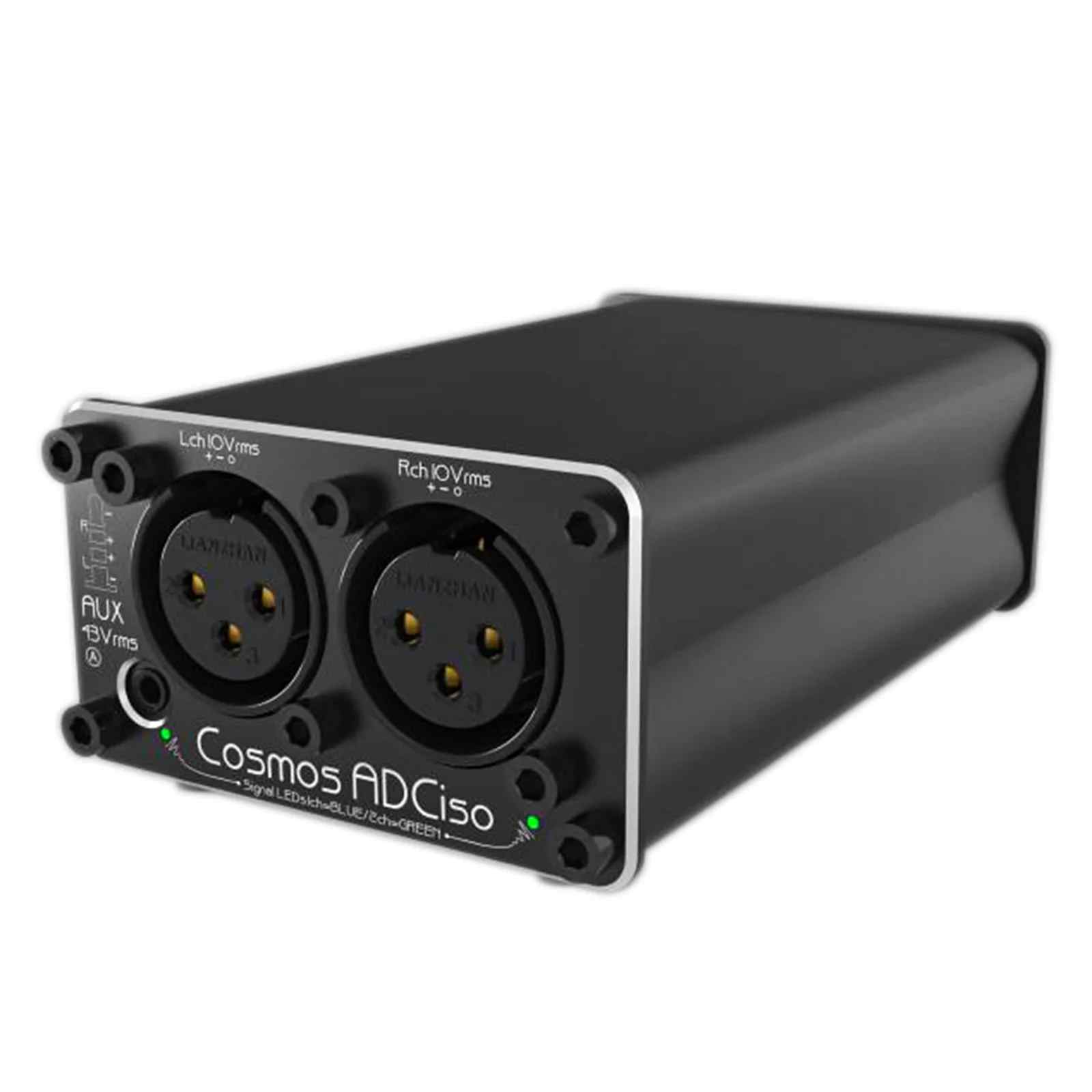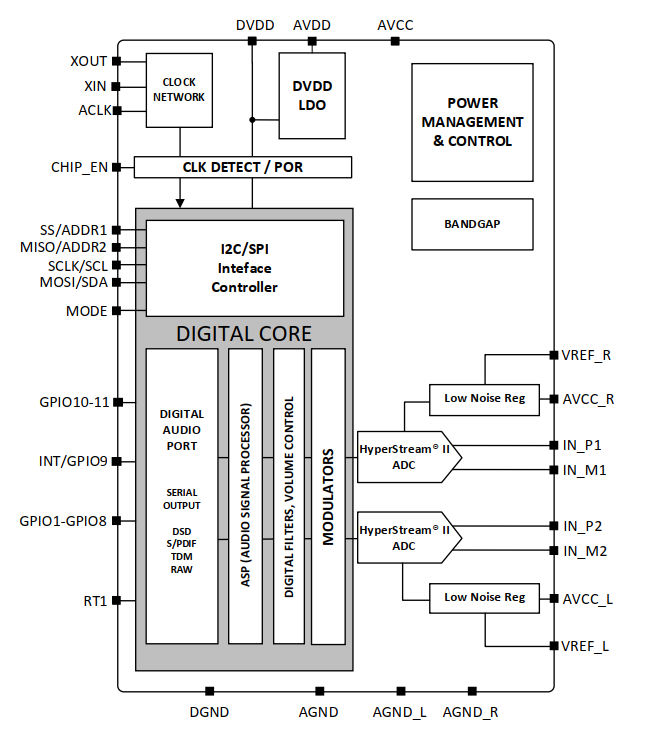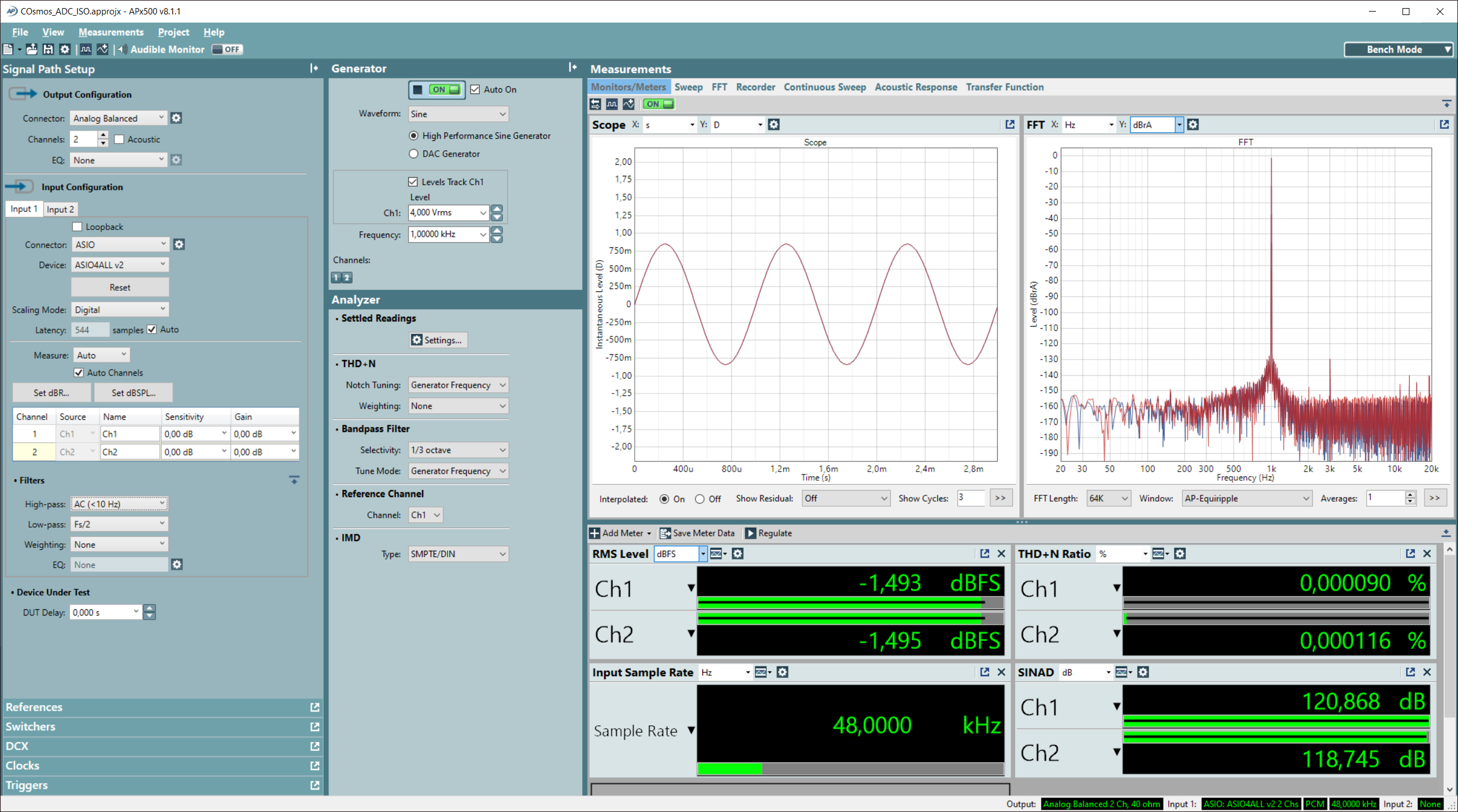High-Precision Analog-to-Digital Converter for Audio Testing.
This ADC is a high performance stereo ADC with balanced inputs. The USB interface is isolated to avoid ground-loops.
You can use this ADC for high quality recording and low distortion and low noise measurements.
The E1DA Cosmos ADCiso uses the ADC Sabre ES90822PRO.
Does a 300$ ADC reach the performance of a 50000$ audio analyzer?


in general the E1DA Cosmos ADC is used as an USB soundcard. Since it is intended for measurements, it has no windows mixer and you can adjust the gain with DIP switches.
Specification E1DA Cosmos ADC iso (from the manufacturer)
SNR/DR
Grade A: 128-129dB(A) Grade B: 126-128dB(A) Measured in MONO mode; SNR/DR in STEREO mode is 3dB lower; Measured at 32/48 with an AP2700
Dimensions
104x61x39mm (PCBA: 90x50x29mm) Weight 157g (PCBA: 34g)
Power supply
2x USB-C +5V rail, <250mA current/separated for ADCiso Input
USB bridge Comtrue CT7601CR(ADCiso CT7601PR with native 768K) Custom FW
Max input voltage
XLR L/R (FDA) up to 10Vrms AUX 2.5mm Jack up to 43Vrms
digital Output
USB-C, PCM up to 32b/768kHz/ADCiso has that connector isolated with 8pF
Latency
5mS@192k ASIO4ALL REW (Measured as a physical delay/2 from ADC input to the 9038D output)
Frequency Response
0.8Hz-320kHz @ 32b/768kHz -3dB
THD+N and THD
THD+N@
Crosstalk
< -140dB @ 1kHz / ADCiso <-153dB if not used inputs are shorted
ADC Sabre ES90822PRO
The Sabre ES9822 PRO is the world's highest performance 32-bit analog-to-digital (A/D) converter targeted for professional audio applications such as recording systems, mixer consoles and digital audio workstations (DAW), test equipment, instruments, audio processors, digital turntables, and consumer applications.

The ES9822 PRO has 2 integrated ADCs which deliver unprecedented audio sound quality and specifications, including a DNR of 128dB in mono mode and a DNR 125dB, THD+N of -117dB in 2 channel mode.
The Sabre ES90822PRO supports synchronous SPDIF, I2S master/slave, or native DSD output. For the most demanding audio enthusiast, the ES9822 PRO is capable of outputting RAW data, allowing the user to apply their own custom handling of the data.
The Audio Signal Processor (ASP) integrated in the ADC allows for custom filtering such as RIAA presets to be implemented in the ADC, eliminating the need for re-processing later in the signal path.
The ES9822 PRO has an Ultra-Low Noise Floor Bandwidth of 200kHz. This bandwidth is up to 10 times wider than the competition, enabling higher resolution at higher sample rates.
Specification
- +125dB DNR 2 channel mode
- +128dB DNR in mono mode
- -117dB THD+N 2 channel mode
- -118dB THD+N in mono mode
Data output and sample rates
- High Sample Rates up to PCM 768kHz including 1.536MHz w/Double Data rates Up to DSD512
Features
- Audio Signal Processors (ASP) | Available for custom FIR filters for any applications, including RIAA
- Multiple Output formats available | PCM, TDM, DSD, S/PDIF, RAW
- Customizable filter characteristics | 8 presets, and programmable filter coefficients for custom sound signature
- 2 audio signal processors for custom filter architectures and analog/digital mixing
- I2C or SPI interface control
Measurements of the E1DA Cosmos ADC with our APX555
First, we start with a dashboard using an ASIO driver. We use the low distortion generator of the APX555 with 4V RMS

In addition, we made measurements with our software Akulap.

And REW (Room Equalization Wizard)

In total we reach a THD around 130dB.
For pure comparison a loopback of the APX555 analyzer. Does the E1DA Cosmos ADC reach the performance of our reference analyzer?

You can easily see, that the high end audio analyzer is still better. Harmonics at 3khz are 20dB lower!
But: The APX555 uses a high-performance signal analyzer mode. This is basically a dual ADC with a notch filter.
For the next test we switch off this feature, to measure the pure raw ADC of the APX555.

And it is not surprising, that the E1DA Cosmos ADC is slighly better!
But this measurement is at one point 4V RMS@1kHz.
The world best ADC does not give you a complete high-end analyzer.
Let's look at a level sweep and compare the APX555 with the Cosmos ADC.

Does a 300$ ADC reach the performance of a 50000$ audio analyzer?
Yes, and no. From the pure ADC performance the E1DA Cosmos ADC is slightly better. This means, if you put the E1DA Cosmos ADC to its sweet spot, you can perform world leading measurements.
However, the ADC performance is just a fraction of the function you need in practice.
Things you will miss, by using the E1DA Cosmos ADC
- E1DA Cosmos ADC has low input impedance depending on the gain settings. You might need an extra buffer-amp. But it's performance must match the ADC
- APX555 has a high performance signal analyzer mode
- APX555 has automatic/manual gain control
- APX555 has an ultra low distortion signal generator
In general, the Cosmos ADC is a very powerful tool, if you know how to use it. And this unit is cheap! Of course, if budget does not count, buy an APX555.
Mono mode E1DA Cosmos ADC
The ADC supports a mono mode to reduce noise, it can be set via volume mixer or tweak software.
Once I find time, I'll take a look at it and document the results.....
Calibrated E1DA Cosmos ADCiso with individual measurement report
From the manufacturer you do not get any individual measurement report. You get some rough specification, but you have no info about your individual device.
We fill this gap and sell measured units. You will get a complete measurement report. The makes the E1DA Cosmos ADC more reliable, because you know the detailed performance and can reference to it.
In addition, we measure your device, if you already have an Cosmos ADC.


